The Federal Aviation Administration had laid down its groundbreaking safety rules for choppers in February of 2014, popularly known as the HAA (helicopter air ambulance) rule. It mandated that the choppers involved in emergency transport of the patient would have to meet requirements like:
- Inclusion of certain specific safety instruments
- Improved training and testing
- Establishment of control systems for air ambulance transport vehicles
These were only a few requirements that were laid down. Although the initial deadline to meet these requirements was April 22 of last year, it was then extended by a year owing to the difficulties of the air ambulance transport companies to comply with them at such short notice. Most air ambulance transport companies have already complied with the first set of rules, although there is some anxiety in the air ambulance transport industry as the deadline nears.
The Air Ambulance Transport Sector will have to Meet More Deadlines
Although the air ambulance transport companies will have to comply with several of the rules laid down this year, there are some for which the sector still has time. Here’s a breakdown.
Compliance by April 2016: Setting up of operations control center.
Compliance by April 2017:
- Installation of radio altimeters
- Incorporation of warning systems and terrain indicators for choppers
- Meeting qualification criteria for PIC instruments
Compliance by April 2018: Complying with mandated systems to monitor flight data.
Guidance is awaited by the Air Ambulance Transport Industry
The sources in the air ambulance transport industry revealed that it is not possible to comply with certain mandates unless there are clear guidelines by the FAA. Compliance with most of the rules will cost the air ambulance transport operators huge dollars, so obviously, they want to get it right and keep the expenses to a minimum.
For the pilots, crew and the people travelling in air ambulance transport vehicles, the rules will bring in more safety and efficiency. In general, the rules have been well accepted by the air ambulance transport industry so far.


